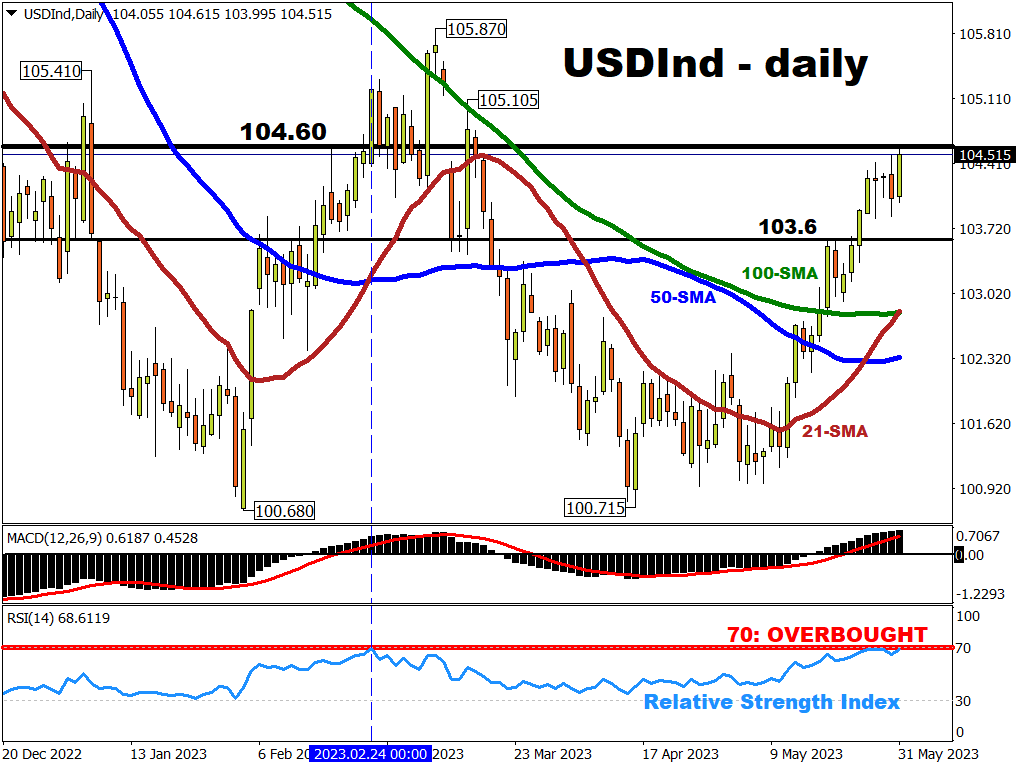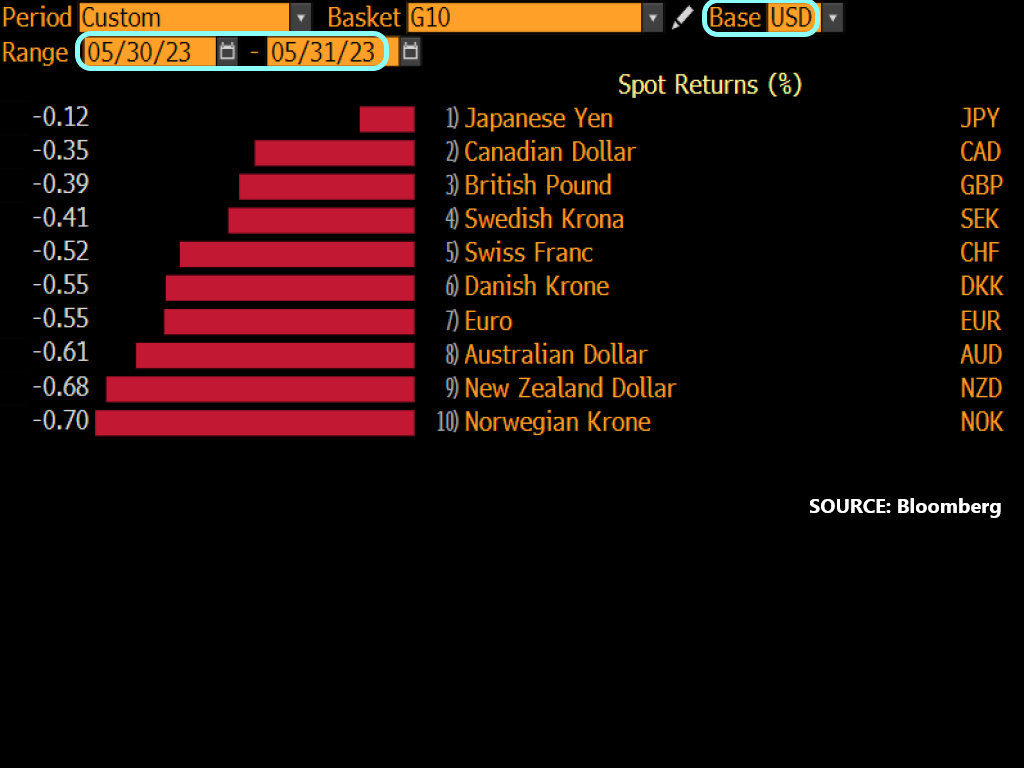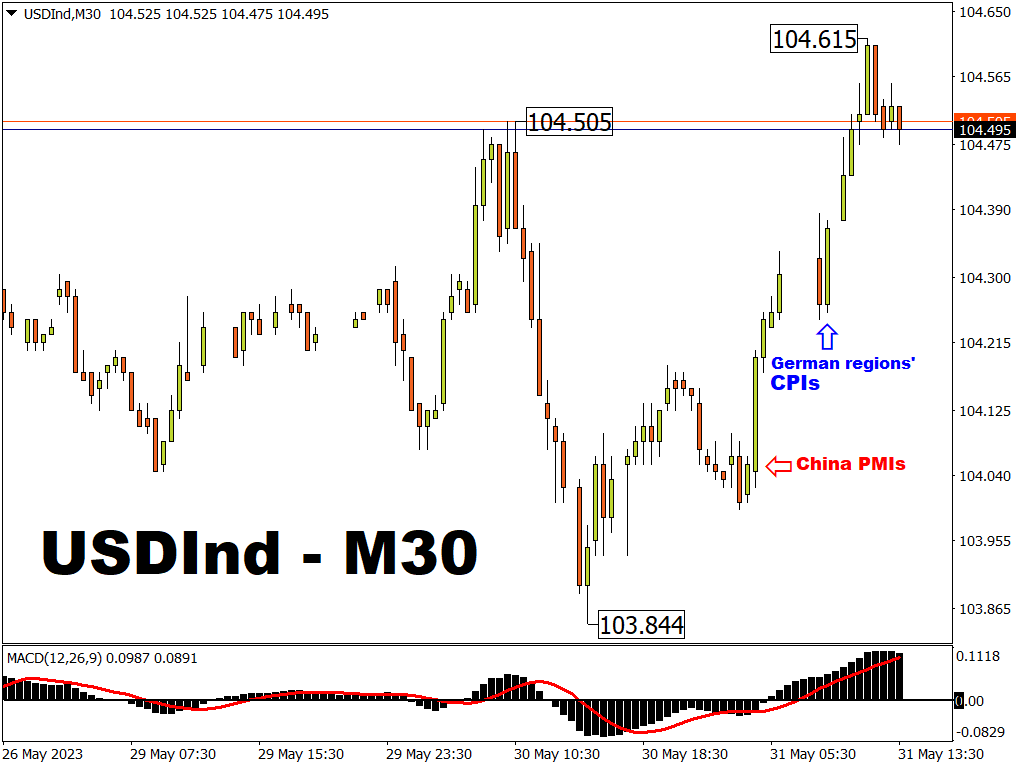- Here are 3 reasons why the dollar bulls (those hoping prices will move higher) are having a wonderful Wednesday:
- Technical Perspective: Where to possibly next for the USD index?
The USD Index has punched its way to a fresh two-month high, and is on course for its largest monthly gain (2.8%) since September 2022.

NOTE: The USD Index tracks how the US dollar is performing against a basket of six different G10 currencies, including the euro, British Pound, and Japanese Yen.
Also, the US dollar has strengthened against all of its G10 peers today:

Here are 3 reasons why the dollar bulls (those hoping prices will move higher) are having a wonderful Wednesday:
1) China’s weaker-than-expected data prompted demand for safe haven dollar
Earlier today, China revealed that its purchasing managers’ index (PMI) for its manufacturing sector (think of factories) and non-manufacturing sector (think of services) both came in below market expectations.
Hence, markets got spooked on signs that the recovery in the world’s second largest economy is not on solid footing, especially as fears of a recession abound.
And when investors are traders are fearful, they flock to safe haven assets which help protect one’s wealth in times of great fear and uncertainty.
With the US dollar long been seen as a traditional safe haven, no surprise that China’s wobbly recovery in turn drove the US dollar higher.
2) Germany and France’s lower-than-expected inflation data weakened the euro, in a further boost for USD
First, some important notes:
-
Germany and France are the two largest economies in the Eurozone.
-
The European Central Bank (ECB) has been hiking interest rates aggressively to bring inflation down from its record high.
-
A currency softens at the thought of interest rates not moving higher.
- The euro is the largest component of the USD Index, with the former accounting for 57.6% - more than half – of the benchmark index.
With all of the above in mind, today’s announcements that inflation in the Eurozone’s two largest economies are slowing down further, that suggests that the ECB has less reasons to keep hiking its benchmark rates much further.
And in this zero-sum game that is the FX markets, with the Euro (more than half of the USD index) weakening at the thought of a less-aggressive ECB, that allowed the US dollar to punch higher!

Furthermore, and this brings us back to reason #1, the Eurozone is very dependent on the Chinese economy. The Eurozone economy will feel the effects of a slowdown in the Chinese economy.
Hence, there was less demand for the euro today in light of China’s weaker-than-expected PMI data, which in turn bolstered the US dollar.
3) US debt-ceiling deal moving closer to Congress approval, restoring faith in dollar
Later today, the US House of Representatives (the lower body of Congress) is set to vote on the tentative deal to raise the US debt ceiling.
This tentative deal, struck between US President Joe Biden (Democrat) and Speaker Kevin McCarthy (Republican) over the weekend, would ensure that the US government can issue more debt to get the cash it needs to keep paying its bills.
Otherwise, failure to raise the debt ceiling (allow the US government to issue more debt), would trigger a catastrophic default by the US government for the first time in history!
Although this tentative deal faces a race against time in requiring approval before the June 5th deadline, markets are hoping that the deal will be approved, thus restoring faith in US assets including the US dollar.
Technical Perspective: Where to possibly next for the USD index?
Potential upside scenario:
At the time of writing, this index is facing immediate resistance around the 104.60 region, which had also resisted bulls on January 3rd and February 17th earlier this year.
A daily close above this 104.60 level could set the USD Index on course for these key levels:
Potential near-term resistance:
-
105.00 (psychologically-important handle).
-
105.105 (March 15th high)
- 105.27 – 105.41 (early Jan- late Feb highs)
Bullish technical crossover?
The US dollar may also draw a bullish cue from the fact that its 21-day simple moving average (SMA) has crossed above its 100-day counterpart.
The last time this technical event (21-day SMA crossed above 100-day SMA) happened was in mid-2021.
After that last bullish episode, the USD Index then went on a 15-month winning streak that culminated in a 23% climb.
Though to be clear, it’s a lot harder to imagine the US dollar going on another 20+% climb from here, given the macro headwinds facing the US economy as well as expectations that the Fed will lower interest rates in 2024.
Potential downside scenario:
However, if the US dollar’s upwards momentum fails to hold over the immediate future, bears (those hoping prices will move lower) would be eager to test these key levels:
Potential near-term support:
-
103.8 (intraday lows during recent consolidation)
- 103.4 – 103.6
Technical pullback soon?
Also, note in the chart at the top of this article, that the USDInd’s 14-day relative strength index (RSI) has broken above the 70 threshold which denotes “overbought conditions”.
In the prior instance of this technical event (RSI breaking above 70) back in late February, the USD Index then fell by about 4.4% over the following seven weeks.
Dollar tends to fall in June over past 30 years
It remains to be seen whether the USD Index can reverse the downtrend that’s in place, having posted a series of lower highs and lower lows since late September 2022.
Although dollar bulls are enjoying their time in the sun currently, history may be against them.
Since 1993, the month of June has averaged a monthly drop of 0.27%.
And with the US debt ceiling drama set to be extended into the new month, coupled with a highly-anticipated Federal Reserve meeting due in a couple of weeks ...
time will tell whether dollar bulls will still be basking in the sunshine by this time next month.